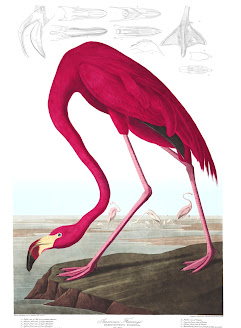For many years I was somewhat ambivalent in my opinion about the bird drawings of John James Audubon. And it is difficult to pinpoint exactly when and why this changed. Perhaps the tide turned during a chance conversation in 2018 about Audubon's art when it was pointed out to me that ...'this is ART!'
Indeed this is 'Art', not just bird art.
Some would argue (as I once did) that many of Audubon's birds are stylized and are not natural looking. That the pose is contrived. Would you actually see a heron in the wild as drawn above by Audubon? Maybe not. But that is one reason that this is 'art'.
For many of us the gold standard of bird illustrations are the lithographs of John Gould. Audubon's drawings are very different from Gould's. With Audubon you quite often get the charismatic virtuosity of Paganini's caprices for the violin, compared to the soothing lyricism of Chopin's preludes for the piano as with Gould. And just as it is with a piece of music, once you've listened to it a few times and have begun to understand what the artist is striving for, so it has been for me with Audubon's bird drawings.
A Louisiana heron preens itself at the edge of a swamp. The vegetation appears to have been ravaged by a storm in the not-too-distant past.
A pair of curlews probes for crustaceans and mollusks with their impossibly-long bills. Just as the inhabitants of the city in the background would have searched for their fortunes in those exciting times in America?'(Audubon)... explored the American wilderness from Galveston Bay to Newfoundland, hunted with Shawnees and Osages, rafted the Ohio and the Mississippi, identified, studied and drew almost five hundred species of American birds, saw English noblemen kneel before him to examine his dazzling drawings, raised the equivalent of several million dollars to publish a great work of art, wrote five volumes of "bird biographies" larded with narratives of pioneer life, won fame enough to dine with presidents and become a national icon, "The American Woodsman", his ultimate appellation, a name he gave himself.'
This 'great work of art' is, of course, 'The Birds of America'. Initially drawn over the course of five years from 1820 to 1825, it was first published in 1827. Audubon continued to add drawings of new birds to the book over the next ten years or so.
Audubon wanted to illustrate his birds almost life-size. He chose to make the drawings in double- elephant folio, each engraved and hand-coloured plate sized about two-by-three-foot.
Using this folio size would still present obvious problems: how do you fit a drawing of a very large bird, such as a flamingo, or a crane, or even a heron, onto a 2x3 ft. sheet? And still manage to make these illustrations comparable to those of tiny birds, such as hummingbirds?
This is how such paintings compare on the actual plates. Not unsurprisingly, the flamingo's neck has to be swung right down to the toes to fit the plate (but that is how they feed, don't they?). The hummingbirds have the run of the sheet - full freedom and space to hover easily over nectar-filled blossoms.
In an earlier post about another classic bird artist Edward Lear, we had seen that he drew most of his birds from captive specimens in zoos.
http://jaipurbirding.blogspot.com/2020/07/edward-lear-bird-artist-extraordinaire.html
Not so Audubon.
Audubon observed at first-hand, in the wild, what he drew. With shotgun in hand he explored large swathes of frontier-expanding America in search of his specimens. Any unfamiliar-looking bird was shot and examined minutely. This may sound unsettling to some readers today, but in most cases it was a necessity from his point of view. Obviously in the early 1820's there were no sophisticated cameras with telephoto lenses. Many of the birds themselves had never been identified or described by science.
By 1826 Audubon was ready with his first tranche of water-colours of American birds. He traveled to England to find an engraver and to start displaying his drawings. Much like the modern day musician, who must perform in front of live audiences to earn from his creative output, he rented halls to display his works- with all the bells and whistles! Yes, literally so, since potential subscribers also needed to be entertained with impersonations of bird calls and with war cries of tomahawk-bearing hard-riding braves.
Over the years Audubon would make several expeditions to different parts of America to add new bird specimens to his collection of drawings. His adventures in the newly-opened frontiers of America make for interesting reading. His writings are evocative of the landscape, of the many perils of the journeys, and of the excitement of the chase. These 'bird biographies' were published as accompaniments to the bird drawings. The bird observations are accurate and detailed enough to for him to be called an ornithologist.
There is also a sense of poignancy as we look at some of the drawings today. For instance, Audubon observed Passenger pigeons in the 'millions'. Modern estimates put their numbers in America at that time at 3 billion! Fully one-third the numbers of all American bird species put together. Now there isn't even one.











Superb works of art. That little part of the essay on Passenger Pigeons was beautifully written. Only a lover of nature could do that.
ReplyDeleteFascinating
ReplyDeleteOh...but these indeed are pieces of art!! Lovely and brilliant!!!
ReplyDeleteSo interesting and enlightening!
ReplyDelete